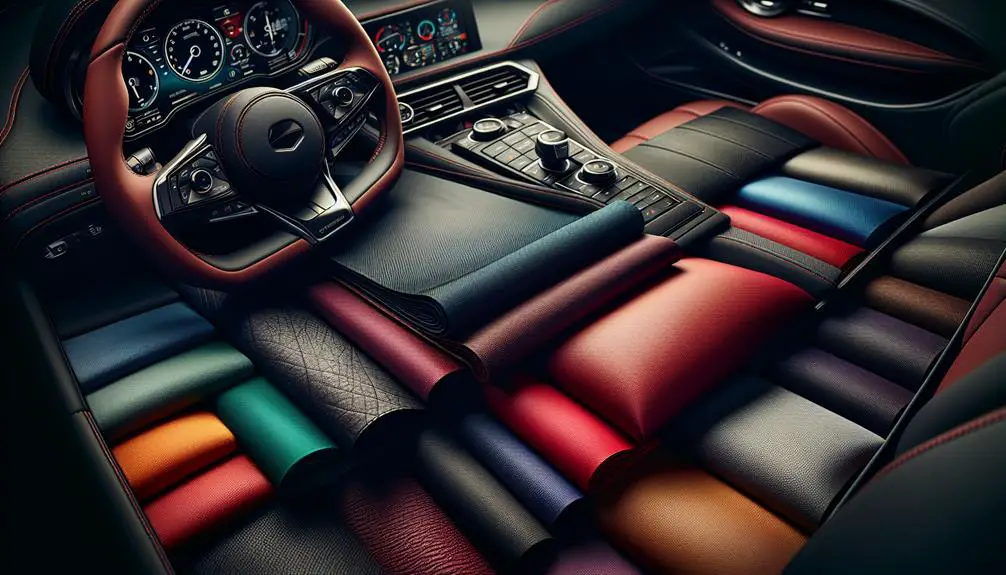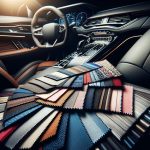Did you know that nearly 60% of car buyers consider interior fabric quality a top priority? When you're selecting fabrics for automotive interiors, you can't overlook factors like durability, comfort, and maintenance. Each type of fabric, whether it's luxurious leather or versatile synthetic options, brings its own set of benefits and drawbacks. These choices not only affect the aesthetic appeal but also the driving experience and long-term upkeep. Curious about how the right fabric can elevate your ride while simplifying maintenance? Let's explore the key considerations that will guide you to the perfect choice.
Table of Contents
Key Takeaways
- Choose fabrics with high wear resistance and UV protection for durability.
- Opt for materials with built-in stain resistance for easier maintenance.
- Select breathable fabrics to enhance comfort during drives.
- Consider eco-friendly fabrics to minimize environmental impact.
- Prioritize neutral colors and versatile designs for better resale value.
Types of Automotive Fabrics
When exploring automotive interiors, you'll find a variety of fabrics designed to meet different needs and preferences. Each type of fabric offers unique benefits, giving you the opportunity to tailor your vehicle's interior to your exact specifications. Understanding these options is essential for making informed decisions.
First, consider the array of color options available. Fabrics come in a spectrum of shades, allowing for extensive customization. Whether you prefer classic tones or bold hues, the right color can transform the ambiance of your car's interior.
Beyond color, pattern selection plays a significant role. With various patterns ranging from subtle textures to intricate designs, you can achieve a level of design flexibility that reflects your personal style.
Moreover, different fabrics offer varying degrees of durability and maintenance requirements. Some fabrics are engineered to resist stains and wear, making them ideal for families or those who spend a lot of time on the road. Others prioritize comfort and luxury.
Leather: Pros and Cons
Leather offers a blend of luxury and durability that's hard to match in automotive interiors. When you choose leather, you're opting for a material that exudes sophistication and stands up well over time. Its durability makes it a popular choice for those seeking long-lasting elegance in their vehicles. Leather can withstand the rigors of daily use, resisting wear and tear better than many other materials.
However, leather does come with its own set of challenges, primarily in the domain of maintenance. Regular conditioning is essential to keep the leather supple and prevent it from drying out or cracking. Without proper care, leather can lose its luster and become susceptible to damage. Spills need to be cleaned promptly to avoid stains, and exposure to direct sunlight should be minimized to prevent fading.
On the upside, leather is relatively easy to clean compared to fabric. A quick wipe can often remove dirt and spills, making maintenance more straightforward in some respects. Still, you'll need to invest time and effort into periodic conditioning and protection to truly enjoy the longevity and luxurious feel that leather offers.
Balancing these pros and cons will help you decide if leather is the right choice for your automotive interior.
Fabric Upholstery Options
Fabric upholstery provides a versatile and comfortable alternative for automotive interiors. You can select from a wide range of color options, enabling you to match the interior to your personal taste or the vehicle's exterior. The customization possibilities are nearly infinite with fabric, allowing you to create a unique and personalized driving environment.
Staying abreast of design trends is essential if you aim to achieve a contemporary or classic look. Current trends often highlight bold patterns and textures, adding depth and character to the interior space. By selecting trendy designs, you can guarantee your vehicle's interior remains stylish and modern.
Equally important is upholstery protection. Fabric upholstery can be treated with protective coatings to resist stains, spills, and daily wear and tear. These treatments not only prolong the life of the fabric but also make maintenance easier. Investing in high-quality fabric and protective treatments can save you time and effort in the long run.
Synthetic Materials Overview
Synthetic materials offer a durable and cost-effective solution for automotive interiors, providing a blend of functionality and aesthetics. When selecting synthetic fabrics, you gain access to a wide array of color options and customization features, ensuring your vehicle's interior reflects your personal style. These materials can mimic the appearance of natural fabrics while offering superior resistance to wear and tear, making them ideal for high-traffic areas.
You'll find several benefits when you opt for synthetic materials:
- Color options: Synthetic fabrics can be dyed in virtually any shade, allowing for a wide range of colors to match your design vision.
- Customization features: From embossed textures to intricate patterns, synthetic materials can be tailored to meet specific design requirements.
- Sustainability: Many synthetic fabrics are produced using eco-friendly materials and processes, reducing environmental impact.
- Durability: These materials are engineered to withstand extreme conditions, including UV exposure and temperature fluctuations.
Comfort and Feel
When considering automotive fabrics, you'll want to think about how the texture and softness impact comfort. Fabrics that regulate temperature can make a huge difference in how enjoyable your ride is.
Let's explore how these elements contribute to a pleasant driving experience.
Texture and Softness
The texture and softness of automotive interior fabrics greatly impact the overall comfort and feel of your vehicle. When selecting fabrics, you need to take into account how they complement the color options and design patterns of your car's interior. A well-chosen fabric not only enhances the aesthetic appeal but also contributes significantly to your driving experience.
Pay attention to:
- Thickness: Thicker fabrics tend to provide more cushioning and a plush feel, but they can also impact the breathability of the material.
- Softness: Choose materials that feel pleasant to the touch, as you'll be in contact with these surfaces often. Soft fabrics can make long drives more comfortable.
- Breathability: Fabrics that allow air to circulate can reduce sweating and enhance overall comfort. This is especially crucial in warmer climates.
- Durability: While softness is crucial, the fabric also needs to withstand regular wear and tear without losing its texture or appearance.
Balancing these factors ensures that your car's interior not only looks stylish but also feels luxurious and comfortable. By taking into consideration the interplay between thickness, softness, and breathability, you can make an informed choice that elevates your driving experience.
Temperature Regulation
Efficient temperature regulation in automotive interior fabrics ensures you remain comfortable regardless of the weather outside. When choosing materials, consider their insulation properties and design options. Fabrics with excellent heat retention keep you warm during winter, while those with advanced cooling technology provide a revitalizing feel in the summer months.
To master the art of selecting the right fabric, you need to understand the balance between insulation and breathability. High-quality materials, such as wool blends and advanced synthetics, offer superior insulation properties without compromising on style. Design options, like perforated leather or mesh inserts, can also enhance airflow and improve overall comfort.
Here's a quick comparison of various fabric options:
| Fabric Type | Insulation Properties | Cooling Technology |
|---|---|---|
| Wool Blends | High | Moderate |
| Perforated Leather | Moderate | High |
| Mesh Inserts | Low | Very High |
| Advanced Synthetics | Variable | Variable |
Durability Factors
Durability in automotive interior fabrics hinges on factors like material composition, wear resistance, and maintenance practices. You need to take into account abrasion resistance and colorfastness if you want fabrics that withstand daily wear and tear.
Abrasion resistance guarantees that the material can handle friction without showing signs of wear. Colorfastness ensures that the fabric maintains its vibrant hues despite exposure to sunlight and frequent use.
To achieve a high level of durability, focus on these critical aspects:
- Material Composition: Choose fabrics made with sturdy fibers like nylon or polyester, recognized for their strength and resistance to damage.
- Wear Resistance: Look for materials that undergo thorough testing for wear and tear, ensuring they can withstand prolonged usage without degradation.
- UV Resistance: Opt for fabrics treated to resist ultraviolet light, preventing fading and material breakdown from sun exposure.
- Stain Resistance: Select fabrics with protective coatings that repel liquids and stains, preserving their appearance over time.
Maintenance Requirements
When considering fabrics for your car's interior, you'll want to think about stain resistance and how often you need to clean them. Some materials repel stains better than others, reducing the effort required to keep them looking fresh.
Regular cleaning frequency can vary greatly depending on the fabric's properties and your lifestyle.
Stain Resistance
To maintain the pristine appearance of your car's interior, it's important to grasp the stain resistance of the fabrics utilized. Stain-repellent textiles provide sturdy protection and effortless cleaning, making them a superb option for preserving the visual charm of your vehicle. Advanced spill-resistant technology guarantees that liquids and other substances don't seep into the fabric, ensuring enduring quality.
When opting for fabrics, take into account these key characteristics:
- Sturdy Protection: Premium materials are treated to fend off stains, ensuring they stay looking fresh for an extended period.
- Effortless Cleaning: Fabrics with integrated stain resistance necessitate minimal exertion to clean, saving you time and inconvenience.
- Spill-Resistant Technology: Contemporary fabrics are engineered to repulse liquids, thwarting spills from transforming into permanent stains.
- Enduring Quality: Investing in stain-resistant fabrics signifies that your car's interior will uphold its appearance over time, even with frequent use.
Selecting the appropriate stain-resistant fabric is vital for individuals seeking a low-maintenance, high-functioning interior. You won't only relish the peace of mind that accompanies sturdy protection but also the convenience of easy cleaning. By concentrating on these attributes, you guarantee that your vehicle's interior remains spotless and welcoming.
Cleaning Frequency
Regular cleaning of your car's interior fabrics not only maintains their appearance but also extends their lifespan. To accomplish this, you'll need to contemplate the right cleaning products and frequency. High-quality cleaning products can remove dirt, stains, and odors effectively without damaging the fabric. Make sure to adhere to the manufacturer's recommendations for cleaning frequency, typically every few months, depending on usage.
DIY cleaning techniques offer several benefits. They're cost-effective and give you control over the cleaning process. Start by vacuuming to remove loose dirt and debris. Use a fabric cleaner suitable for automotive interiors, applying it with a soft brush or cloth. Gently scrub the fabric in circular motions, making sure you cover all areas evenly. Blot the fabric with a clean, dry towel to absorb excess moisture.
Regular maintenance using these DIY techniques not only keeps your car looking pristine but also helps preserve the fabric's integrity. Remember, the key to a well-maintained interior is consistency. By adhering to a regular cleaning routine and using the right products, you'll guarantee that your car's interior fabrics remain in top condition for years to come.
Cost Considerations
Evaluating the cost of fabrics for automotive interiors involves considering multiple factors, including material durability, manufacturing methods, and market demand. When handling budget constraints, you'll need to weigh quality trade-offs.
Cheaper materials might seem attractive initially, but they can lead to higher costs down the road due to frequent replacements or repairs. Material cost comparison is essential for identifying fabrics that provide long-term savings and investing in high-quality materials upfront can reduce future expenses and enhance the overall vehicle value.
Here's what to keep in mind:
- Durability: Select materials that withstand wear and tear, even if they come at a higher initial cost.
- Production Techniques: Efficient manufacturing methods can lower costs without sacrificing quality.
- Market Demand: Popular materials might be more expensive but offer better resale value.
- Supplier Reliability: Consistent, high-quality supplies can save you from costly delays and defects.
Environmental Impact
Choosing eco-friendly fabrics for automotive interiors can greatly reduce the environmental footprint of vehicle production. When you opt for sustainable materials, you're not just making a choice for your car, but also for the planet.
Fabrics made from recycled materials or natural fibers like organic cotton and bamboo are excellent eco-friendly options. These materials minimize waste and reduce the demand for new raw materials, which in turn lowers greenhouse gas emissions and conserves energy.
You should also consider the entire lifecycle of the fabric. Sustainable options should be durable and long-lasting, decreasing the need for frequent replacements. This durability contributes to a lower environmental impact over time.
Additionally, look for fabrics that are produced with non-toxic dyes and chemicals, which further reduces their ecological footprint.
Resale Value Impact
Opting for high-quality fabrics in your car's interior can greatly enhance its resale value. When you select premium materials, not only do you enjoy an immediate improvement in comfort and aesthetics, but you also invest in your vehicle's long-term worth. High-end fabrics tend to withstand wear and tear better, ensuring that the interior remains pristine for longer.
Consider the following points to maximize resale value:
- Color choices: Neutral and classic colors often appeal to a broader audience and offer a timeless look. These choices can have a significant longevity impact, maintaining appeal over the years.
- Design options: Selecting fabrics with versatile design options allows future owners to envision the car fitting their style. It's about creating an inviting and adaptable space.
- Customization possibilities: High-quality fabrics often come with customization possibilities, enabling you to tailor the interior to your liking. This personalized touch can be a strong selling point.
- Durability and maintenance: Fabrics that are easy to clean and maintain will always be more attractive to potential buyers, as they reduce future upkeep costs.
Frequently Asked Questions
How Do Fabric Choices Affect Sound Insulation in a Vehicle?
When choosing fabrics, you'll find they impact noise reduction and thermal properties to a large extent. Opt for materials with high durability and easy cleaning maintenance to guarantee long-term effectiveness in sound insulation for your vehicle's interior.
Are There Hypoallergenic Fabric Options for Car Interiors?
Yes, there are hypoallergenic fabric options for car interiors. You can choose eco-friendly options that not only reduce allergens but also offer customizable designs, ensuring both health benefits and aesthetic appeal for your vehicle.
What Are the Best Fabrics for Extreme Weather Conditions?
For extreme weather conditions, you should opt for water-resistant options and UV protection fabrics. They guarantee durability and comfort, safeguarding against rain, spills, and sun damage, keeping your car's interior pristine and long-lasting.
How Do Fabric Colors Influence a Vehicle's Interior Temperature?
Fabric colors greatly impact a vehicle's interior temperature. Lighter fabric shades reflect sunlight, aiding in temperature control and energy efficiency, while darker colors absorb heat, making the interior warmer and potentially less energy-efficient.
Can Fabric Treatments Improve Resistance to Pet Damage?
Imagine your car's interior transformed… Yes, fabric treatments can greatly enhance resistance to pet damage. With stain protection and enhanced durability, these treatments also offer odor control, ensuring your vehicle's longevity and pristine condition.







